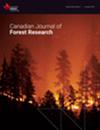加拿大北部寒冷地区山地松甲虫袭击后松树再生不良。
IF 1.5
3区 农林科学
Q2 FORESTRY
引用次数: 0
摘要
最近,山松甲虫(MPB, Dendroctonus ponderosae)从其北美西部的原生地扩展到加拿大阿尔伯塔省北部的北方松林,导致树木再生的条件与野火(这些森林中主要的自然干扰)后的条件截然不同。我们评估了加拿大艾伯塔省北部针叶松地在mpb后的自然再生:通过对33个严重受损松树林的小块地进行密集调查,并使用205个永久样地的数据,代表了不同的样地类型和mpb死亡率水平。我们使用模型选择来确定解释再生的因素。总体而言,mpb后6-9年,松木再生非常差;在集中调查的33个样地中,只有42%有松树苗,205个永久样地中只有9%有松树苗。这种较差的再生是由于这些种群中高水平的球果群落,由于未受干扰的凋落物或羽苔层而不适合再生的微点,以及来自剩余冠层和林下植被的竞争。其他树种(白杨、桦树、白杨、黑白云杉)在大多数地点被发现,要么是攻击后再生,要么是提前建立的再生。如果不进行干预,这些林分中的许多可能会从松树过渡到阔叶和其他针叶树物种。本文章由计算机程序翻译,如有差异,请以英文原文为准。
Poor regeneration of pine after mountain pine beetle attack in colder boreal regions of Canada.
The recent expansion of mountain pine beetle (MPB, Dendroctonus ponderosae) from its native range in western North America into northern boreal pine forests in Alberta, Canada has resulted in conditions for tree regeneration that are dramatically different from those after wildfire, the predominant natural disturbance in these forests. We assessed natural regeneration post-MPB for northern boreal lodgepole pine sites in Alberta, Canada: via intensive surveys of small plots at 33 severely-attacked pine stands, and using data from 205 permanent sample plots representing various site types and levels of MPB-mortality. We used model selection to identify factors explaining regeneration. Overall, pine regeneration was very poor 6-9 years post-MPB; only 42% of the 33 intensively surveyed plots, and only 9% of the 205 permanent plots, had pine seedlings. This poor regeneration is attributed to high levels of cone serotiny in these populations, unsuitable regeneration microsites due to undisturbed litter or feathermoss layers, and competition from the residual canopy and understory vegetation. Other species (aspen, birch, poplar, black and white spruce) were found on most sites, either as post-attack regeneration or regeneration established in advance. Without intervention, many of these stands will likely transition away from pine, to broadleaf and other conifer species.
求助全文
通过发布文献求助,成功后即可免费获取论文全文。
去求助
来源期刊
CiteScore
4.20
自引率
9.10%
发文量
109
审稿时长
3 months
期刊介绍:
Published since 1971, the Canadian Journal of Forest Research is a monthly journal that features articles, reviews, notes and concept papers on a broad spectrum of forest sciences, including biometrics, conservation, disturbances, ecology, economics, entomology, genetics, hydrology, management, nutrient cycling, pathology, physiology, remote sensing, silviculture, social sciences, soils, stand dynamics, and wood science, all in relation to the understanding or management of ecosystem services. It also publishes special issues dedicated to a topic of current interest.

 求助内容:
求助内容: 应助结果提醒方式:
应助结果提醒方式:


